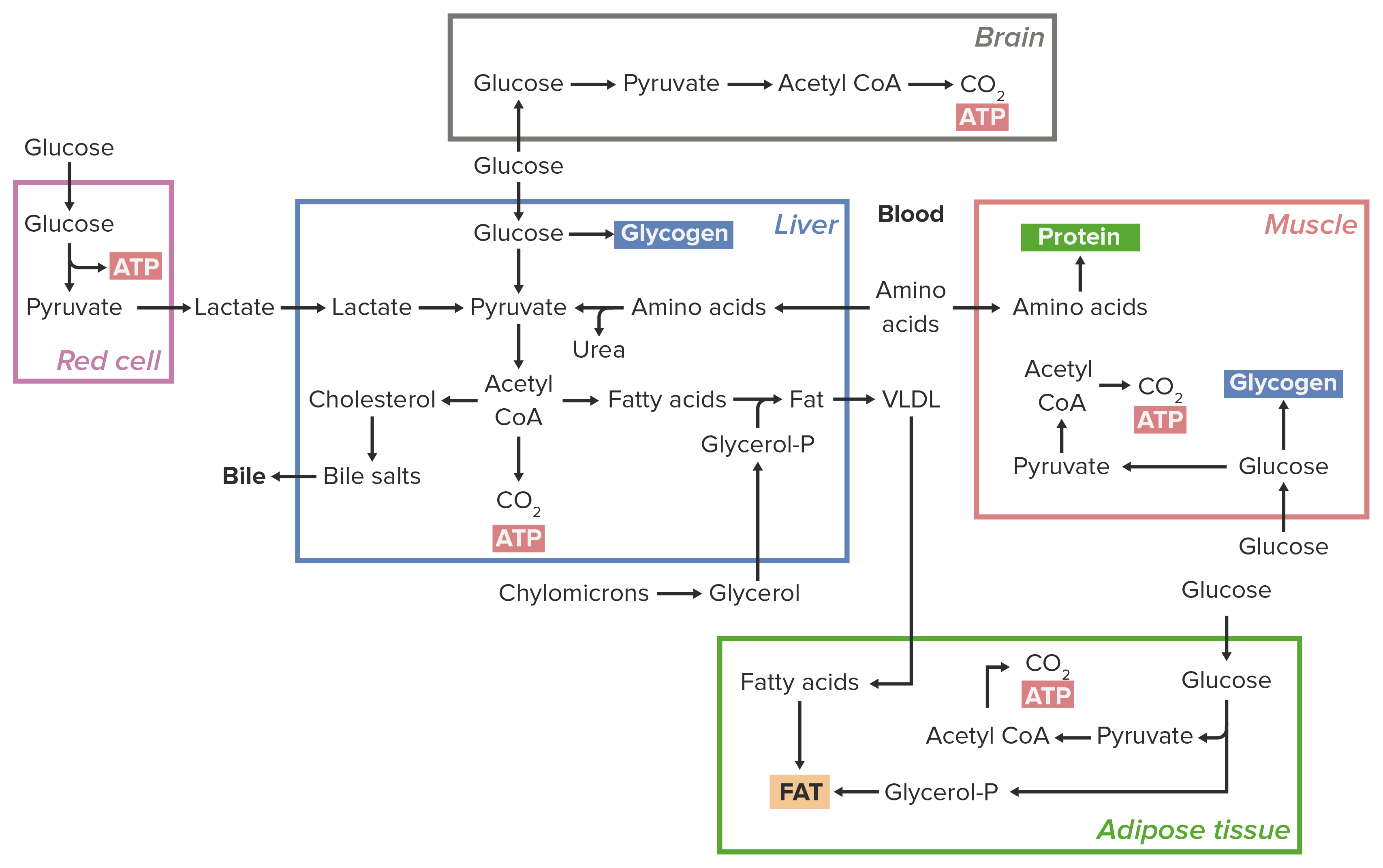Playlist
Show Playlist
Hide Playlist
Energy Considerations in Nutrition
-
Slides EnergyConsiderations Nutrition.pdf
-
Download Lecture Overview
00:01 In this lecture we will be reviewing some of the energy considerations relative to nutrition that you need to have right in your pocket for your medical licensing exams. 00:12 These things include basal metabolic rate as well as body mass index, total energy expenditure, as well the fuel caloric values and so forth. 00:23 So moving into - looking at basal metabolic rate, most often we'll consider resting metabolic rate. 00:30 Because it's the much more simple measurement to make. 00:33 Resting metabolic rate doesn't take into account having to have 12 hours of fasting and necessitate 8 hours of sleep. 00:42 It's a simple measurement taken upon waking and getting up. 00:47 So resting metabolic rate is generally, we use in an equation to calculate our basal metabolic rate. 00:57 But if we are going to do it very clinically, we would measure the VO2 at various times, on various days. 01:05 But again we will generally use an equation to calculate basal metabolic rate. 01:11 And I'll introduce you to or help you review two of them that will be important for you to keep in mind. 01:18 This first one, you probably just need to know the name of. 01:23 But if you want to go beyond that, you could memorize the equation. 01:27 We're not going to spend the time deriving it. 01:30 But it takes into account the age of the individual as well as the gender weight and height. 01:36 And you can see that there is an adjustment over there on the right hand side based on the gender. 01:43 Whether it's a male or a female. 01:45 And again you don't need to understand where the numbers come from. 01:50 It's a plug and chug kind of thing, Measuring height in centimeters and weight in kilograms. 01:55 More commonly, these days though the Katch-McArdle formula is utilized in which we consider pretty standard numbers. 02:06 Let us say a woman has 25% body fat, if she weighs 50 kgs, her lean mass would be 50x0.75 = 37.5 kg. BMR can then be computed to be equal to BMR = 370 + (21.6 x lean mass). 02:25 The catch here is that we have to know the body fat percentage. 02:30 And that turns out to be not so difficult to ascertain these days. 02:35 Of course you can do Caliper testing but there are bioelectrical impedance devices that patients can just hold on to and we get a fairly decent estimate or at least relative estimate of the body fat percentage. 02:47 So we can calculate lean mass by subtracting the body fat percentage. 02:54 So Katch-McArdle is the one I would certainly commit to memory and keep in your pocket for use on your exam. 03:01 Now total energy expenditure is the energy we use beyond our basal metabolic requirements. 03:11 Plus, all the other things that we do in a day. 03:14 So all our caloric needs over a 24 hour period, first of all you probably realize but maybe haven't thought about it in the total energy expenditure realm. 03:26 That when we consume food it actually costs as calories to consume and digest that food. 03:35 So that is the thermic effect of feeding. 03:38 And that's about a 10% of our total energy expenditure in a day. 03:43 Now of course in addition to that we have some physical activity. 03:47 Some of that physical activity is activity that we choose to do as we move around. 03:52 But even when we are sitting still, we are still burning calories. 03:58 And we need to add this physical activity, whether it's intended exercise or general mobility, we need to add this to our basal metabolic rate. 04:11 So there's the component of physical activity that we call NEAT. 04:18 Another term you should be familiar with. 04:19 Which is our Non-Exercise Activity Thermogenesis. 04:22 So this is when your sitting at your desk and you feel like you're doing nothing and not burning any calories. 04:28 In fact, we are burning calories during that because we have to have muscles firing to keep us upright and not in a pile on the floor. 04:36 So all of these pieces go into the calculation of total energy expenditure. 04:43 And then how do we calculate the physical activity piece of this. This is can be pretty controversial calculation I suppose because as always when people give us numbers, they vary from source to source. 05:00 But in general we will take our basal metabolic rate and multiply it by a certain factor dependent on the activity level. 05:11 So someone who is sedentary will have a lower factor to multiply by than someone who is particularly active. 05:16 Again you'll see a vast difference in the actual figures provided. 05:24 What I recommend is that you get a perspective of what sort of factor it is. 05:29 So somewhere between 1 and 2. 05:33 However, we really know that there are extreme athletes. 05:36 People that are riding century rides. 05:38 Ultramarathoners might run 50 miles in a day. 05:42 They are certainly going to be above the extremely active level. 05:47 So you might even see numbers towards 3. So don't go memorizing the numbers. 05:51 Just sort of get a relative idea that physical activity is multiplying the basal metabolic rate by a particular factor.
About the Lecture
The lecture Energy Considerations in Nutrition by Georgina Cornwall, PhD is from the course Nutrition.
Included Quiz Questions
What percentage of total energy expenditure is accounted for by the thermic effect of feeding?
- 10
- 20
- 5
- 7
- 30
Which of the following statements concerning basal metabolic rate is correct?
- Body fat % is essential to use the Katch-McArdle formula.
- Fasting is not necessary for the calculation of the basal metabolic rate.
- The height of the patient is not necessary to calculate BMR using the Mifflin-St. Jeor formula.
- The basal metabolic rate is not affected by age.
- No energy is consumed while sitting.
Which of the following is TRUE of the resting metabolic rate?
- It is easier to calculate than basal metabolic rate because the patient is not fasting.
- It is more strict than the basal metabolic rate.
- It can be performed while the patient is asleep.
- It will be slightly lower than the basal metabolic rate.
- It takes into account physical activity energy expenditure.
Customer reviews
5,0 of 5 stars
| 5 Stars |
|
5 |
| 4 Stars |
|
0 |
| 3 Stars |
|
0 |
| 2 Stars |
|
0 |
| 1 Star |
|
0 |




